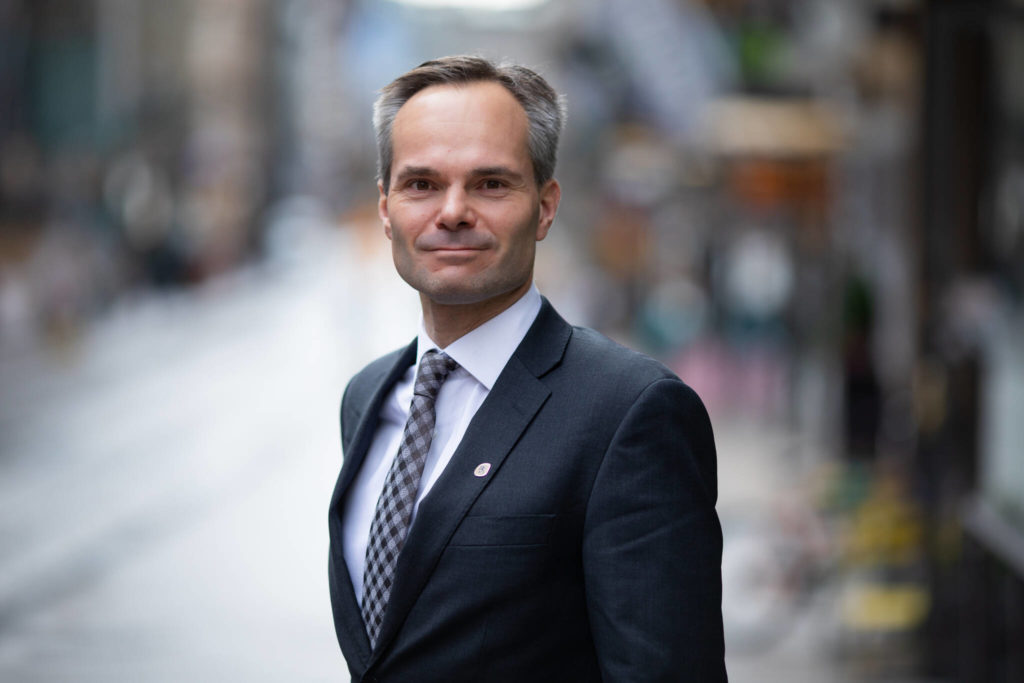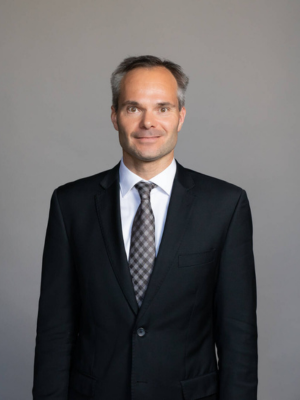Kai Mykkänen, Minister for Climate and the Environment: Packaging regulation must be clear and proportionate

Packaging waste is a topic that the Minister of Climate and the Environment, Kai Mykkänen, deals with both at work and at home. “My wife constantly comments on the ‘intermediate storage’ of our packaging waste, since looking after it is my responsibility,” says Mykkänen, who lives in a single-family house in Espoo with his wife, two children and a dog.
Apart from the intermediate storage situation, Mykkänen finds the routines related to sorting and recycling of packaging waste easy to handle. Boxes for sorting packaging waste have their own place in the kitchen, and there are rarely any problems with the sorting instructions either. “We sort cartons, plastic and glass packaging as well as metals. Since we live in a detached house, we don’t have recycling containers in the garden, other than the compost bin. I usually take recyclable packaging once a week to the RINKI ecopoint in Tapiola, Espoo, on my way to the shops,” says Mykkänen.
The difficult Packaging Waste Regulation
It is easy to understand why packaging waste waiting to be recycled piles up. There are no spare minutes in the minister’s diary. He starts work well before 8 in the morning and finishes late in the evening.
For the past few months, even his desk has been covered with packaging waste, at least figuratively, in the form of a proposal for the new EU Packaging and Packaging Waste Regulation, a project that has been taking up a lot of Mykkänen’s time recently. The EU’s ministers for the environment reached an agreement on the draft regulation in late 2023.
“It’s right to try to reduce packaging waste, but the proposal contains several points that are problematic for Finland. For example, we have a well-functioning system for certain deposit bottles that also has excellent recycling rates. The regulation makes no sense if we must abandon the system due to the new requirements,” says Mykkänen.
Will there be more tools to monitor free-riders?
At least the current proposal by the Member States, i.e. the Council, saw necessary compromises reached during negotiations. The Council agreed to relax some bans on single-use packaging and targets for the reuse of packaging, for example. The reuse targets would not apply to packaging for milk or other perishable beverages. The ban on packing fruit and vegetables with a total weight under 1.5 kilograms in single-use packaging would also only apply to plastic packaging. Similarly, restaurants would still be able to use single-use wraps made of material other than plastic when serving on site.
It is also positive that the proposed definition of a producer is aligned with the current definition in Finland. The Council will also simplify the reporting process for packaging. More tools would be available to monitor free-riders, as producers selling products through online platforms would have to declare that they have fulfilled their producer responsibility obligations. Service platforms would need to assess the reliability of information, request that producers solve any problems and, if necessary, block sales.
There is still a lot to improve. “The negotiations are ongoing, so we don’t know the final content of the regulation yet. The ministry is working hard to promote the changes that are important for Finland,” says Mykkänen, who served as Minister of the Interior and Minister for Foreign Trade and Development in Sipilä’s government in 2016–2018.
The proposal for the Packaging Waste Regulation will next be discussed in the trilogues of the European Commission, Parliament and Council, which will aim to find a compromise between the positions of the European Parliament and the Member States.
Sensible regulation, please
Inadequate interpretations, late implementing acts, incorrect guidelines and the Commission’s strict provisions have meant a difficult last few years for packaging producers in terms of regulation.
“Some of the proposed new requirements under the Packaging Waste Regulation are aimed at the same packaging producers as the requirements in the SUP Directive, and it’s understandable that in this respect the new requirements seem to be coming too fast,” says Mykkänen.
Mykkänen points out that the current Packaging Waste Directive was adopted as early as 1994. Thus, there is a need for comprehensive reform that will take a wider look at the entire life cycle of packaging and propose new measures to promote circular economy as well as reduce the use of natural resources and the amount of packaging waste generated.
“But it’s important that future legislation is clear, proportionate and appropriate. For example, the requirements of the Packaging Waste Regulation to promote reuse would mean the implementation of large-scale and costly changes in certain industries, so the requirements must be justified,” says Mykkänen.
Uncertainty of investments is a challenge
In addition to societal influence, environmental issues have been important to Mykkänen since he was a child. Mykkänen carried out his first political campaign when he was in school, collecting signatures for a petition to save a conservation area in Espoo. He describes himself as a ‘rational idealist’, and that is also his approach to the producer responsibility system.
“There is a lot that is good in the producer responsibility system, but one of the challenges is the uncertainty related to investments. In terms of textiles, for example, the plans to switch to a producer responsibility system have reduced the incentives for municipal waste management companies to invest in a separate collection and reuse scheme for end-of-life textiles from consumers,” Mykkänen says in his straightforward style.
At the EU level, the producer responsibility system is seen as a way to have a say on products at the design stage as manufacturers – and also, in the case of packaging, companies that pack products – will have to take responsibility for the end of their product’s life cycle, i.e. when they become waste. Until now, producer responsibility has mainly had an impact on recycling, but more requirements are being introduced concerning products and their manufacturing processes, as well as extending their life cycles.
The outgoing European Commission, headed by Ursula von der Leyen, has taken decisive action. Its work has been characterised by a belief in authority and close attention to detail, and issues related to packaging waste and producer responsibility are no exception – quite the opposite. Mykkänen says that producer responsibility currently plays a very important role in the EU’s waste and product policy, something that is unlikely to change under the new Commission.
“It seems that the importance of producer responsibility will be even greater in the future, and there will be proposals to include more product categories within its scope.”
Plastic packaging needs to be recycled
No other material has attracted as many column inches in recent years as plastic and, in particular, the problems with recycling it. Mykkänen’s family also generates quite a lot of plastic packaging waste.
“Plastic is always the first to overflow from its container, which goes to show how much plastic packaging is used by a family with children.”
The new methods for calculating recycling rates reduced the recycling rate of plastic packaging in particular, as a large proportion of plastic collected separately is not suitable for use as raw material to make new products. The Commission issued a warning to Finland and 18 other Member States that they are at risk of falling short of the 50% recycling target for plastic packaging set for 2025. The Commission has recommended that Finland take measures such as encouraging reuse, improving separate collection and offering advice on waste, as well as applying economic instruments to reduce waste incineration.
Mykkänen says that much is being done to increase the recycling rate of plastic packaging. The Ministry of the Environment and Circular Economy Finland will organise a series of events this spring to find a common policy to promote recycling and reuse. The PlastLIFE project, which runs for several years, contributes to the implementation of the Plastics Roadmap for Finland and the sustainable circular economy of plastics.
“Several mutually supportive measures are required to increase the recycling rate for plastic packaging,” the minister points out. These include a wide-scale implementation of the new separate collection requirements and encouraging households and companies to step up their recycling efforts. Packaging should also be designed to be easy to recycle. “It will also be necessary to develop recycling technologies for plastics and increase the use of recycled materials in new products,” says Mykkänen.
Plastic circulation must be organised properly, but Mykkänen is glad to point out that many materials are already circulated efficiently in Finland. Legislation on sorting and recycling is already rather comprehensive, and Finland has a functioning system for collecting other types of packaging waste. It seems that the EU’s tightening recycling targets for metal, glass and carton packaging will also be reached in the future. These are also in great demand as raw material for new products. Eventually, it will also be possible to increase the recycling rate of plastic packaging.
WHO
 Kai Mykkänen, Minister of Climate and the Environment (The National Coalition Party)
Kai Mykkänen, Minister of Climate and the Environment (The National Coalition Party)
- Minister of Climate and the Environment in Orpo’s government and third term as MP.
- Master of Social Science.
- Prior to serving as an MP, Mykkänen worked as a special adviser to a minister and director at the Confederation of Finnish Industries.
- Mykkänen lives in Espoo with a spouse, two sons and Nakki the dog.
- His hobbies include ball games, jogging and reading literature on social issues.